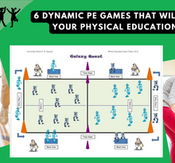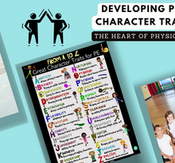Understanding the transformative effects of exercise on the human body is essential for all physical education teachers. It enables them to develop a curriculum that promotes fitness, educates students about the health benefits of regular activity, and inspires lifelong healthy habits. This article provides an in-depth exploration of the physiological changes that occur during exercise, as experienced by the exercising individual.

Also, don't forget to check out the end of the blog where you can download a FREE visual entitled "What happens to my body when I exercise?" You can use it for reference during your PE and health teaching segments.
What Happens to my Body When I Exercise?
Check out the ways a body responds to exercise and physical activity below!
My Heart Beats Faster: The Cardiovascular System in Action

When exercising, the heart beats faster to meet the increased oxygen and nutrient demands of the body. This increase in heart rate is essential to ensure the optimal functioning of major muscle groups, providing them with the energy necessary for the task at hand. The cardiovascular system plays a vital role in maintaining this delicate balance, adjusting the heart rate proportionally to the exercise intensity.
I Begin to Sweat: Thermoregulation and Exercise

As the body's workload increases, so does its internal or core body temperature. Sweating is the body's cooling mechanism, helping to prevent overheating. Sweat, released through the skin's pores, evaporates, thereby dissipating heat and helping to maintain a stable body temperature even during strenuous exercise.
I Get Thirsty: Hydration and Exercise

Thirst is the body's signal that it needs more water to compensate for the fluid loss that occurs through sweating. Staying hydrated is crucial during exercise as it supports the healthy function of all body systems, including aiding in temperature regulation and maintaining blood volume for proper blood flow.
My Brain Produces Endorphins: The Exercise 'High'

Exercise stimulates the production of endorphins, chemicals in the brain that act as natural painkillers and mood elevators. Often described as the 'runner's high', this endorphin boost can improve mood and produce a feeling of well-being, contributing to the mental health benefits of exercise.
I Breathe Harder: The Respiratory Response to Exercise

Breathing rate increases during aerobic exercise to meet the heightened oxygen demand of active muscles. Deeper and more frequent breaths allow the body to intake more oxygen and expel carbon dioxide, a waste product of metabolism within muscle cells.
Blood Flow Increases to My Brain: The Cognitive Boost

Physical activity prompts increased blood flow to the brain, supplying it with more oxygen and nutrients. This has been associated with enhanced cognitive function, memory, and improved focus, illustrating the mental benefits of regular exercise.
Blood Flow Increases to My Muscles: Fueling Activity

Exercise leads to a marked increase in blood flow to the skeletal muscles, essential for meeting the muscles' increased demand for oxygen and nutrients. This enhanced blood supply also aids in muscle recovery post-exercise by helping to remove waste products, including lactic acid, which can contribute to muscle soreness.
Increased Pressure to My Bones: The Role of Weight-bearing Exercise

Weight-bearing exercises, including those that utilize one's own body weight, apply pressure to the bones, stimulating the formation of new bone tissue and increasing bone density. This process helps to maintain skeletal health, reducing the risk of conditions such as osteoporosis.
I Get a Tired Feeling: Understanding Muscle Fatigue

As the body works harder during exercise, muscles experience fatigue due to factors like energy depletion, lactic acid buildup, and micro-tears in muscle fibers. This tired feeling is a natural response to the increased demands placed on the body and can help prevent overexertion and injury. After a workout, especially a strength training session involving major muscle groups, it's also normal to experience fatigue. This can cause temporary muscle discomfort or delayed onset muscle soreness (DOMS). However, as the body adapts to regular exercise, it becomes more efficient at managing these factors, reducing the sensation of fatigue over time.
It Gets Difficult to Talk: The Talk Test

As exercise intensity increases, so does the demand for oxygen, which can make it more challenging to hold a conversation. This can lead to heavier breathing and a limited ability to engage in conversation during exercise, as the body prioritizes oxygen delivery to the muscles over speech. This phenomenon forms the basis of the 'talk test' – a simple, informal way to gauge exercise intensity.
Final Thoughts
Moderate intensity exercise, such as aerobic activities and strength training that targets major muscle groups, provides an array of health benefits – from muscle hypertrophy and improved cardiovascular health to enhanced cognitive function. Regular exercise promotes muscle health, reduces blood pressure, and helps maintain a healthy body weight.

Physical education teachers are in a unique position to impart these insights to their students, emphasizing the importance of physical activity and guiding them through an age-appropriate exercise program. By fostering an understanding of how exercise benefits the body and mind, teachers can inspire students to lead active, healthy lives.
Do you talk to your students about the way exercise impacts the body before, during, or after they engage in physical activity? Share your tips and strategies with us in the comments below!
FREE visual for your learning space!
Do you need a practical way to highlight 10 important body reactions that occur during exercise or while participating in an intense PE Activity, all in one glance? If so, Cap'n Pete's Power PE has you covered!

Fill out the form below to download a Physical Education exercise effects visual that you can use to reference when working with your students. The PE Poster: What Happens to my Body During Exercise? (in 5 color schemes) serves as a practical instructional graphic to use to showcase 10 important exercise/physical activity effects that occur in the human body. The statements are brief, yet POWERFUL!
This freebie set will be sure to enhance your PE program for years!
Need more visual resources to help with your teaching?
Teaching physical education can be difficult. There are so many different things to cover, and it's hard to know what is the most important. I can help you make teaching PE simpler with engaging, student-friendly graphics that you may utilize on your gym wall or via a monitor. Visual aids can assist make physical education instruction much more simple. They break down complex topics into easy-to-understand visuals that will engage your students and help them learn.
If you're looking for high-quality visuals to help you teach PE and health, go with the Cap'n Pete's Top Physical Education Posters - 25 Set Super Bundle.
You can download the bundle (or individual resources) from either of the following platforms: Cap'n Pete's Power PE Website or Teachers Pay Teachers- Cap'n Pete's TPT Store


















